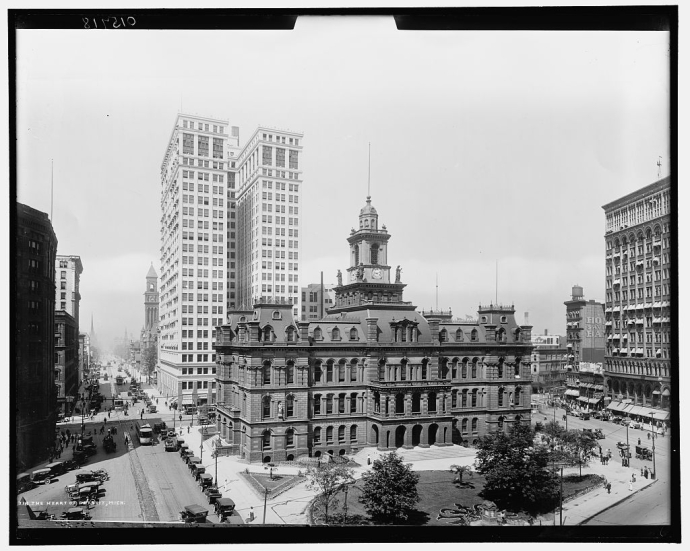The Heart of Detroit, Michigan, Town Hall from 1910 – pulled from the Library of Congress.
By David Stewart
There are few major urban cities that can match the ups and downs that Detroit has weathered over the course of its 300+ year history. This is a tough city made up of resilient people, which gives rise to the notion of “Detroit Strong.” Looking over a few points of history, we can see what made it such an enduring metropolis.
The Anishinaabe or “Three Fires” people have lived in Detroit for centuries. This shifted in 1701 when a French soldier and trader named Antoine de la Mothe Cadillac (sound familiar?) petitioned the King of France to establish an outpost along “le détroit,” or canal, connecting Lakes Erie and Huron. The British colonized the area following the French and Indian War, and eventually the colony would trade hands again to become part of the budding United States of America.
In 1805 a hapless smoker named John Harvey set his own barn aflame with the ashes from his pipe, leaving the entire city in ruin but for one stone warehouse and a skyline full of brick chimneys. Governor William Hull and Judge Augustus Woodward would create a plan to rebuild, taking inspiration from the design of Washington D.C.
Nearly 100 years later, Henry Ford would drive the first automobile on the streets of Detroit, and though he was not the inventor of the machine, he is responsible for the assembly line manufacture that persists to this day. Many people don’t realize that Henry Ford only made a few automobiles in Detroit before leaving and setting up a factory in nearby Dearborn. Ford Motors hasn’t actually made a car in the city since 1910!
The auto industry would see major expansions, as would the population of the city, but the cultural soul of Detroit would ring loud in 1959 when Berry Gordy founded Motown Records. The two-story home of operations that he appropriately dubbed “Hitsville USA” would house the likes of The Supremes, The Temptations, Stevie Wonder, Marvin Gaye, and the Jackson 5. Motown would produce 120 hit singles over the next ten years and create a cultural epicenter in Detroit that would shake the world.
Manufacturing and outsourcing woes would see Detroit decline and fall into ruin leading up to the early 2010s. Detroit declared bankruptcy in 2013, which is the first time a major urban city in the United States has done so. But downtown is thriving, thanks to a plethora of outside investments as well as a few key Detroit natives bringing capital to the city once more. Though there has been an upswing in downtown development, Detroiters have been holding it down all along. We can thank Detroiters for maintaining the city as a hub for creativity, art, music, and more despite the financial hardships. Detroit was recently declared by TIME Magazine to be one of the World’s Greatest Places of 2022, one of only five cities to make the list!
For more information about our great city and how it has changed, please check out these two videos. The first is a time lapse of maps and how they’ve evolved, with historic events overlaid. The second is a photographic comparison of how the city has changed but remained the same.
The time-lapse history of Detroit in 8 minutes

A Hundred Years of Detroit: Then and Now | The New Yorker




